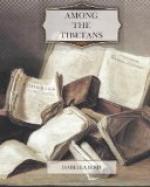Upper and Lower Nubra consist of the valleys of the Nubra and Shayok rivers. These are deep, fierce, variable streams, which have buried the lower levels under great stretches of shingle, patched with jungles of hippophae and tamarisk, affording cover for innumerable wolves. Great lateral torrents descend to these rivers, and on alluvial ridges formed at the junctions are the villages with their pleasant surroundings of barley, lucerne, wheat, with poplar and fruit trees, and their picturesque gonpos crowning spurs of rock above them. The first view of Nubra is not beautiful. Yellow, absolutely barren mountains, cleft by yellow gorges, and apparently formed of yellow gravel, the huge rifts in their sides alone showing their substructure of rock, look as if they had never been finished, or had been finished so long that they had returned to chaos. These hem in a valley of grey sand and shingle, threaded by a greyish stream. From the second view point mountains are seen descending on a pleasanter part of the Shayok valley in grey, yellow, or vermilion masses of naked rock, 7,000 and 8,000 feet in height, above which rise snow capped peaks sending out fantastic spurs and buttresses, while the colossal walls of rock are cleft by rifts as colossal. The central ridge between the Nubra and Upper Shayok valleys is 20,000 feet in altitude, and on this are superimposed five peaks of rock, ascertained by survey to be from 24,000 to 25,000 feet in height, while at one point the eye takes in a nearly vertical height of 14,000 feet from the level of the Shayok River! The Shayok and Nubra valleys are only five and four miles in width respectively at their widest parts. The early winter traffic chiefly follows along river beds, then nearly dry, while summer caravans have to labour along difficult tracks at great heights, where mud and snow avalanches are common, to climb dangerous rock ladders, and to cross glaciers and the risky fords of the Shayok. Nubra is similar in character to Ladak, but it is hotter and more fertile, the mountains are loftier, the gonpos are more numerous, and the people are simpler, more religious, and more purely Tibetan. Mr. Redslob loved Nubra, and as love begets love he received a hearty welcome at Digar and everywhere else.
The descent to the Shayok River gave us a most severe day of twelve hours. The river had covered the usual track, and we had to take to torrent beds and precipice ledges, I on one yak, and my tent on another. In years of travel I have never seen such difficulties. Eventually at dusk Mr. Redslob, Gergan, the servants, and I descended on a broad shingle bed by the rushing Shayok; but it was not till dawn on the following day that, by means of our two yaks and the muleteers, our baggage and food arrived, the baggage horses being brought down unloaded, with men holding the head and tail of each. Our saddle horses, which we led with us, were much cut by falls. Gyalpo fell fully twenty feet, and got his side laid open. The baggage horses, according to their owners, had all gone over one precipice, which delayed them five hours.




